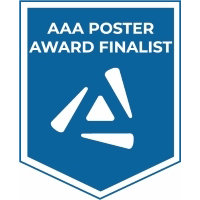Back
ANATOMY
Category: Anatomy
Session: 784 Anatomy: Neural
(784.2) An Exploration of the Sympathetic Component of the Recurrent Laryngeal Nerve
Tuesday, April 5, 2022
10:15 AM – 12:15 PM
Location: Exhibit/Poster Hall A-B - Pennsylvania Convention Center
Poster Board Number: C83
Introduction: AAA has separate poster presentation times for odd and even posters.
Odd poster #s – 10:15 am – 11:15 am
Even poster #s – 11:15 am – 12:15 pm
Introduction: AAA has separate poster presentation times for odd and even posters.
Odd poster #s – 10:15 am – 11:15 am
Even poster #s – 11:15 am – 12:15 pm
Sarah Forman (Kansas City University), Shelby Kuhnert (Missouri Southern State University), Edwin Glueck (Kansas City University), Philip Brauer (Kansas City University), Crystal Lemmons (Missouri Southern State University), Mary Kilmer (Missouri Southern State University), Alla Barry (Missouri Southern State University)
Sarah M. Forman
Presenting Author
Kansas City University
Carthage, Missouri
Presenting Author(s)
INTRODUCTION. High interest in the recurrent laryngeal nerve (RLN) morphology has been dictated by the frequent iatrogenic injures that can result in multifaceted functional losses such as dysphagia, voice alteration, and breathing. Thus, RLN has been extensively studied on the macroscopic and histological levels. According to the literature, RLN is a mixed nerve carrying motor, sensory, and preganglionic parasympathetic fibers to the larynx and displays asymmetry in branching from the vagus nerve. Even though gross anastomoses between RLN and the cervical sympathetic trunk have been observed, the presence of sympathetic postganglionic fibers within RLN have not been addressed. The present study was conducted to determine if catecholaminergic fibers are present within the RLN using immunohistochemical analysis for tyrosine hydroxylase (TH). METHODS. RLN samples were obtained from 19 formalin-preserved adult human cadavers (male n=11, female n=8). Anastomoses with sympathetic structures were noted and documented before obtaining tissue samples for histological examination. Samples were collected one centimeter distal to the RLN branching site. All sections were prepared using Luxol fast blue staining to reveal the presence of myelinated and unmyelinated fibers and TH antibody staining was used to determine the presence of catecholaminergic fibers. Histological slides were then photographed and quantitative analysis of the images was conducted with ImageJ software by measuring of the effective surface area (ESA), TH-positive, myelinated, and unmyelinated. We reported results as mean ± SEM. RESULTS. Neural communications between right RLNs and sympathetic ganglia were observed in two whole-body donors. No statistically significant differences in the number of the fascicles, ESA, myelinated, and unmyelinated fibers between right and left RLNs were found. TH-positive fibers were detected bilaterally or unilaterally in 89.5% of examined donors. Bilateral absence of TH activity throughout the effective surface area was observed in two cases. TH-positive nerve fiber area within the RLNs varied from 0% to 22.14% (Figure 1). The average of TH-positive fibers on the right was 0.045 ± 0.011 mm2 (4.47% ± 1.1% of ESA) and 0.05 ± 0.015 mm2 (5.03±1.5% of ESA) on the left. A positive correlation between the number of unmyelinated fibers and TH-positive component was found (P=0.022 and P=0.0026 on the right and left, respectfully). All parameters, such as fascicles, ESA, myelinated, unmyelinated, and TH-positive fibers, occurred independently of age, gender, or conditions (pgt;0.05). CONCLUSION. Sympathetic postganglionic fibers within RLN nerve exist; however, there is a considerable difference in their number between individuals. However, the origin and functions of this component are ambiguous. SIGNIFICANCE. Knowledge of the sympathetic component of RLN could assist in better understanding the physiological effects and adverse responses of vagus nerve stimulation therapy and the sequala of the RLN injury.

Figure 1. Example of the cross-section of a recurrent laryngeal nerve stained with anti-tyrosine hydroxylase to illustrate distribution of TH- positive fibers within the nerve (circled yellow)

Figure 1. Example of the cross-section of a recurrent laryngeal nerve stained with anti-tyrosine hydroxylase to illustrate distribution of TH- positive fibers within the nerve (circled yellow)

